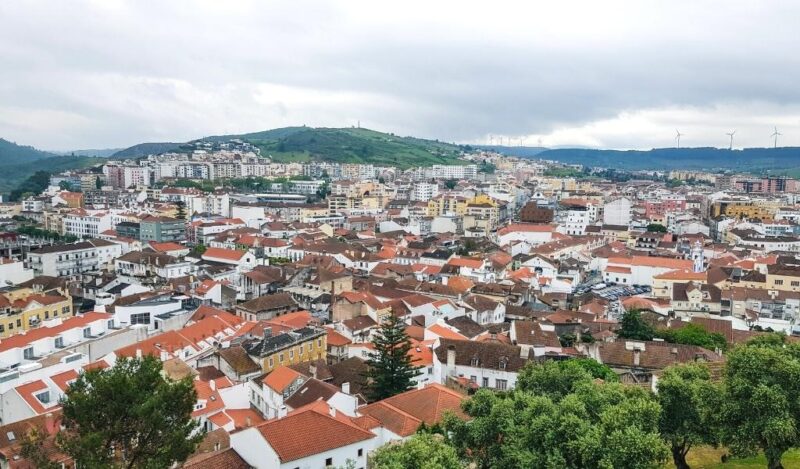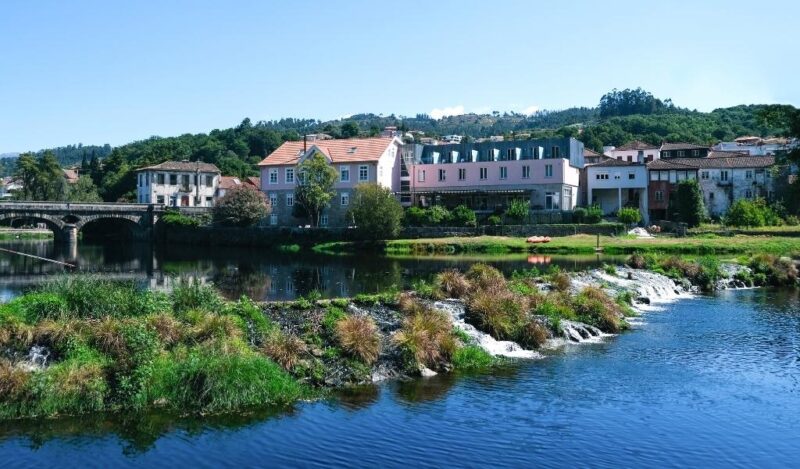Castelo Novo is located in Fundão, the land of the best Portuguese cherry! And this town in the Castelo Branco district is one of the “12 Historical Villages of Portugal” (a program created by the Portuguese government in 1991, to restore and enhance a series of villages in Beira Interior, older than the country itself).
Well, the historical village may be called Castelo Novo (ie “New Castle”), but it has nothing new: after all, we’re talking about more than 800 years of history! With origins linked to the Templars, Castelo Novo developed markedly medieval architecture, but you can find buildings from the Manueline and Baroque periods!
So, do you want to know more about 1 Day In Castelo Novo: The Perfect Castelo Novo Itinerary? Keep reading!
This post may contain affiliate links, meaning I earn a small commission if you make a purchase, at no additional cost to you. Please read my disclosure & privacy policy for more information.
No time to read now? Pin it for later!


Brief History of Castelo Novo
Like so many other Portuguese lands, the town of Castelo Novo was founded by the Order of Knights Templar, after having been offered by the Portuguese monarchs as a form of thanks for the help provided in the Christian Reconquista.
The charter of Castelo Novo was conceived by King Sancho I in 1202, and the castle – built at that time – remained in the possession of the Templars until the extinction of the order in 1312. But a few years later, King Dinis handed over the lands of Castelo Novo to the newly created Order of Christ.

Gradually, the small town of Serra da Gardunha became a strategic point in the country’s defense against Castile, and several Portuguese monarchs reinforced the walled enclosure, towers, and other structures of the military fortress of Castelo Novo. As far as is known, the castle was occupied until the end of the 16th century.
King Manuel I, in turn, decided to rehabilitate the town – which had developed outside the walls – ordering the construction of administrative, judicial, and religious buildings. At the same time, more and more houses were emerging, including noble manor houses.
Visiting Castelo Novo
If you want, you can do as I did and explore Castelo Novo on the same day you visit Idanha-a-Velha and Monsanto, as they are very close (46 km and 47 km, respectively). However, bear in mind that Castelo Novo is a town and not a village – which means that it has many more points of interest!
Honestly, some of the 12 Historical Villages of Portugal can be visited in one morning or afternoon, as is the case of Castelo Mendo, Idanha-a-Velha, Linhares da Beira, Marialva, Piódão, or Sortelha. As for the others, it depends on the number of monuments you want to include in your itinerary.
Since Almeida, Belmonte, Castelo Novo, Castelo Rodrigo, and Monsanto are towns, it’s likely that you’ll need a day (or two) to explore them from one end to the other. And the same happens with Trancoso, which is a city. By the way, here’s the list of the 12 Historical Villages of Portugal:
- Almeida, in the Guarda district
- Belmonte, in the Castelo Branco district
- Castelo Mendo, in the Guarda district
- Castelo Novo, in the Castelo Branco district
- Castelo Rodrigo, in the Guarda district
- Idanha-a-Velha, in the Castelo Branco district
- Linhares da Beira (or simply Linhares), in the Guarda district
- Marialva, in the Guarda district
- Monsanto, in the Castelo Branco district
- Piódão, in the Coimbra district
- Sortelha, in the Guarda district
- Trancoso, in the Guarda district
Castelo Novo Itinerary
Castle of Castelo Novo
The Castle of Castelo Novo is undoubtedly the most important monument in this historical village. In addition to giving the town its name, the fortification is perfectly visible from anywhere in Castelo Novo, as it was built at an altitude of 650 meters!


It’s known that the first mayor of this military fortress was Pedro Guterres and that it suffered numerous destructions and reconstructions throughout its period of occupation. From the current ruins of the Castle of Castelo Novo, it’s still possible to see some structures, such as the:
- South Wall – redesigned in the second half of the 15th century, during the reign of João I
- East Wall and Entrance – dating from the 13th century and renovated in the 14th and 15th centuries
- Clock Tower – built in the second half of the 15th century, it served as a watchtower
- Keep – with a square plan, it was erected between 1202-05 and adapted in the 14th century when the Castle was converted into the Commendator’s Palace
Church of Our Lady of Grace
The Chapel of Our Lady of Grace is also known as the Parish Church of Castelo Novo. Perfectly visible from the imposing Castle‘s Keep, it was built during the 1730s on the ruins of an ancient Catholic temple from the 13th century.

Comprising a single nave with a high choir, two side chapels, and two side altars, the Church of Our Lady of Grace shows an architectural style that was very much in vogue at that time: the rococo. Examples of this are the various altarpieces and also the main altar, in gilded woodwork.
Former Town Hall & King João V Fountain
The Former Town Hall is located in a square of the same name just below the walls, which was the civic center of Castelo Novo for several centuries.
Constructed in Romanesque style around 1290, during the reign of King Dinis, it had a distinct purpose on each floor: the ground floor served as a jail and the town hall functioned on the first floor.
The structure was remodeled by King Manuel I when it received its symbols: the Cross of the Order of Christ, the Armillary Sphere, and the Royal Arms.
Later, when the municipality of Castelo Novo was extinguished in 1835, the building was reused as a school and currently houses the Museum.

As for the João V Fountain, it owes its name to the monarch who ordered it to be built and to the coat of arms it bears on top. Inserted in the center of the main façade of the Former Town Hall, this fountain is made up of three richly ornamented faces, from which water flows.
Pillory

The Pillory of Castelo Novo is located in the middle of the Town Hall Square and dates back to the 16th century when the town received a new charter from King Manuel I.
For this reason, it was decorated with typical elements of the Manueline style, such as plant motifs and the royal insignia.
It’s also relevant to note that the granite column rests on an octagonal staircase with five steps. And that due to its finishing, it’s considered a “pine cone pillory”.
Well, both the number of steps and the type of capital make the Pillory of Castelo Novo a unique example of the Historical Villages of Portugal!
Chapel of the Lord of Mercy
The Chapel of the Lord of Mercy (also called Church of Mercy) is one of the many Catholic temples in Castelo Novo, that proves the devotion of its population since the Middle Ages.
Legend has it that this chapel was built in honor of the Lord of Mercy after he ended a plague of locusts that was devastating agricultural plantations!
The temple dates from the second half of the 17th century and has architectural elements from Mannerism and Rococo.
Nowadays, Castelo Novo celebrates the Festival in Praise of the Lord of Mercy on the first weekend of September.

Bica Fountain

The Bica Fountain has some characteristics in common with King João V Fountain, already mentioned in this itinerary.
To begin with, it was also built at the beginning of the 18th century, under the orders of King João V. And then, it has clear influences from the so-called Joanine Baroque, including the presence of a prominent relief, with the coat of arms of the Portuguese king.
The Bica Fountain is one of the structures that make up Bica Square and deserves special attention from visitors. Among other historic buildings in this square, there are the Parish House and the House of D. Luís de José Correia – as well as the Tourist Office of Castelo Novo.
Correia de Sampaio Family Manor
In addition to churches and chapels, Castelo Novo is a land of stately residences, which attest to the influence and power that the town had in the past: from the Correia de Sampaio Family Manor to the House of D. Luís de José Correia, not to mention the Gamboa Manor and the Falcão Family House!

The Correia de Sampaio Family Manor is better known as Quinta do Ouriço – an exquisite hotel in the heart of the Serra da Gardunha. From the original 18th-century building, it’s still possible to admire the Correia de Sampaio coat of arms on the main façade, as well as the private chapel that was used by the family.
Sainte Anne’s Chapel
Saint Anne’s Chapel was built between the 17th and 18th centuries and is an excellent example of vernacular architecture (a type of architecture that uses materials from the region and doesn’t resort to professional architects).
As you would expect, both the decorative elements and the structure itself are quite simple – even because this Catholic temple is located far from the center of the town.
Dedicated to Saint Anne (mother of the Virgin Mary), the small chapel is right in front of the building of the old Elementary School of Castelo Novo, now in ruins.

Hangman’s Head

This unusual monument on the outskirts of Castelo Novo is deeply related to the traditions of this medieval town.
According to the legend that passed from generation to generation, the two granite blocks got this very “curious” name, because the place was the gallows of the municipality! And yes, you read well!
In the smaller stone above, it’s possible to glimpse reliefs carved on the surface, with… funerary connections.
The most obvious are the two skulls, but there’s also a pair of crossed shinbones under the skulls!
Cross
The last point of interest in this Castelo Novo itinerary is the Cross, about 100 meters from the Hangman’s Head. Located in the First of December Square, it’s, in fact, a commemorative pattern of this date so important to the History of Portugal.

The Castelo Novo Cross was placed in 1940, to mark the 700 Years of the Independence of Portugal and the 300 Years of the Restoration of the Independence (occurred in the year 1140 and on December 1st, 1640, respectively).
Map of the Castelo Novo Itinerary
Share this blog post on your social media!
More Posts about Portugal
4 Best Monasteries In Portugal (That You Should Visit This Year)
5 Best Palaces In Sintra (That You Should Visit This Year)
1 Day In Penafiel: The Perfect Penafiel Itinerary
More Posts about Travel Itineraries
1 Day In Penafiel: The Perfect Penafiel Itinerary
1 Day In Torres Vedras: The Perfect Torres Vedras Itinerary
2 Days In Arcos De Valdevez: The Perfect Arcos De Valdevez Itinerary
What Photography Gear Do I Use?
- Camera Body: Fujifilm X-T4 Mirrorless
- Camera Lens: Fujinon XF 18-55 mm F2.8-4 R LM OIS
- Tripod: Manfrotto Compact Action
- Small Tripod: Manfrotto PIXI Mini
- Smartphone Adaptor: Manfrotto PIXI Clamp
- Memory Card: SanDisk 128GB Extreme PRO SDXC





